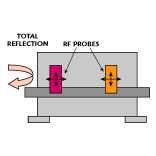A Low Cost, 1200 MHz Frequency Synthesizer
Programmed Test Sources Inc. (PTS)
Littleton, MA
As wireless production expands, test systems requiring high performance LO sources are proliferating. To address the price pressures found in the wireless market, a new low cost synthesizer that features fast switching and low phase noise covering the 1 to 1200 MHz frequency range has been introduced. The model L1200 is a good choice for testing wireless devices in the 800 to 1000 MHz bands and features a frequency switching speed of 20 ms, phase noise of -120 dBc/Hz at 20 kHz offset and spurious outputs of -60 dBc or better. Figure 1 shows the synthesizer's phase noise specification.
To address the price pressures found in the wireless market, a new low cost synthesizer that features fast switching and low phase noise covering the 1 to 1200 MHz frequency range has been introduced. The model L1200 is a good choice for testing wireless devices in the 800 to 1000 MHz bands and features a frequency switching speed of 20 ms, phase noise of -120 dBc/Hz at 20 kHz offset and spurious outputs of -60 dBc or better. Figure 1 shows the synthesizer's phase noise specification.
Synthesizer Design
The device's fast switching speed and good phase noise are achieved by a combination of direct digital and direct analog techniques. For frequency resolution covering a 200 MHz bandwidth, the model L1200 architecture employs a pure-decimal direct digital synthesis (DDS) technique to produce frequency increments up to 2 MHz with 1 Hz resolution (0.1 Hz optional) and provide fine-grained phase control for digital phase modulation applications. The 2 MHz bandwidth signal is upconverted to a 10 MHz bandwidth signal from 140 to 150 MHz where it also incorporates the final 1 MHz digit setting. (For example, a seven in the programmed megahertz decade results in a 147 MHz upconverted signal.)
The 10 MHz steps are derived from a signal comb of 10 MHz multiples covering 10 to 170 MHz generated from the frequency standard. A wideband oscillator covering 485 to 675 MHz in 20 10 MHz steps is used as an LO to upconvert the necessary 10 MHz multiple to a 505 MHz IF. At this point, a narrowband 505 MHz filter selects the upconverted 10 MHz multiple and rejects all other signals by at least 80 dB. Following the filter, the 505 MHz signal is utilized to upconvert the 140 to 150 MHz fine resolution signal to 365 to 355 MHz.
Finally, this signal is mixed with the same wideband oscillator signal and the lower sideband is selected. The result is a low noise output signal spanning 120 to 320 MHz formed fundamentally by the addition or subtraction of a 10 MHz multiple with the directly synthesized 140 to 150 MHz signal. Noise and drift effects of the oscillator are canceled by virtue of the double-conversion loop architecture.
The 200 MHz bandwidth signal covering 120 to 320 MHz carries the programmed frequency modulo 200 MHz. The final 200 MHz increment is generated from a switched-filter design that selects from three high frequency LO signals (1000, 1200 and 1400 MHz) generated from the 10 MHz frequency reference. The 120 to 320 MHz signal is further upconverted via an 1120 MHz LO to cover 800 to 1000 MHz. When mixed with the appropriate high frequency LO, the result is a signal in the DC to 600 MHz band as programmed by the user. Frequencies in the upper 600 to 1200 MHz band are generated by an automatic doubling process, which generates a fundamental signal in the 300 to 600 MHz range and doubles and filters the output signal appropriately. The synthesizer's block diagram is shown in Figure 2 . The resulting synthesizer's key performance specifications are listed in Table 1 .
|
Table I | ||
|
Frequency Range (MHz) |
1.000 000 to 1199.999 999 | |
|
Frequency Resolution (Hz) |
1 | |
|
Switching time (m s) |
| |
|
Output Level (dBm) |
+3 to +13 (1 Vms (max), 50 W ) | |
|
Spurious Outputs | ||
|
Discrete (dBc) |
-65 1 to 600 MHz | |
|
Harmonics (dBc) |
-30 (-35 at lower power levels) | |
|
Phase Noise (dBc) |
-60 (0.5 Hz to 15 kHz, including standard effects) | |
|
L (1 Hz) (dBc) |
100Hz/-100, 1 kHz/-110, 10 kHz/-120, 100 kHz/-122 | |
|
Noise Floor (dBc/Hz) |
-135 | |
Synthesizer Applications
Synthesizers find application in a variety of test systems. The low phase noise and low spurious of the model L1200 synthesizer make it an ideal LO for RFIC testing both as part of the source-stimulus chain and for measurement-related downconversions. Frequency-hopping spread spectrum and other frequency-agile applications require an agile LO and, in this application, the switching speed capability of the synthesizer makes it an ideal source. Finally, in high speed digital applications, the low noise produces a clock source with extremely low jitter.
When precision clock alignments or calibration of phase-detection circuits is required, the unit can be equipped with DDS-based digital phase rotation. Using this option, precise and repeatable phase shifts over the 0° to 360° range can be performed with resolution to 0.45° and speeds of 3 ms or better.
Conclusion
In today's competitive environment, manufacturers must be able to reduce product testing costs. For test applications that emphasize throughput, the combination of fast switching, low phase noise and competitive price provided by the L1200 synthesizer proves an attractive alternative to previous-generation signal sources. The model L1200 synthesizer is priced at $6700 with front-panel manual control and $6400 with remote control only (BCD parallel interface).
Programmed Test Sources Inc. (PTS),
Littleton, MA
(978) 486-3400.
